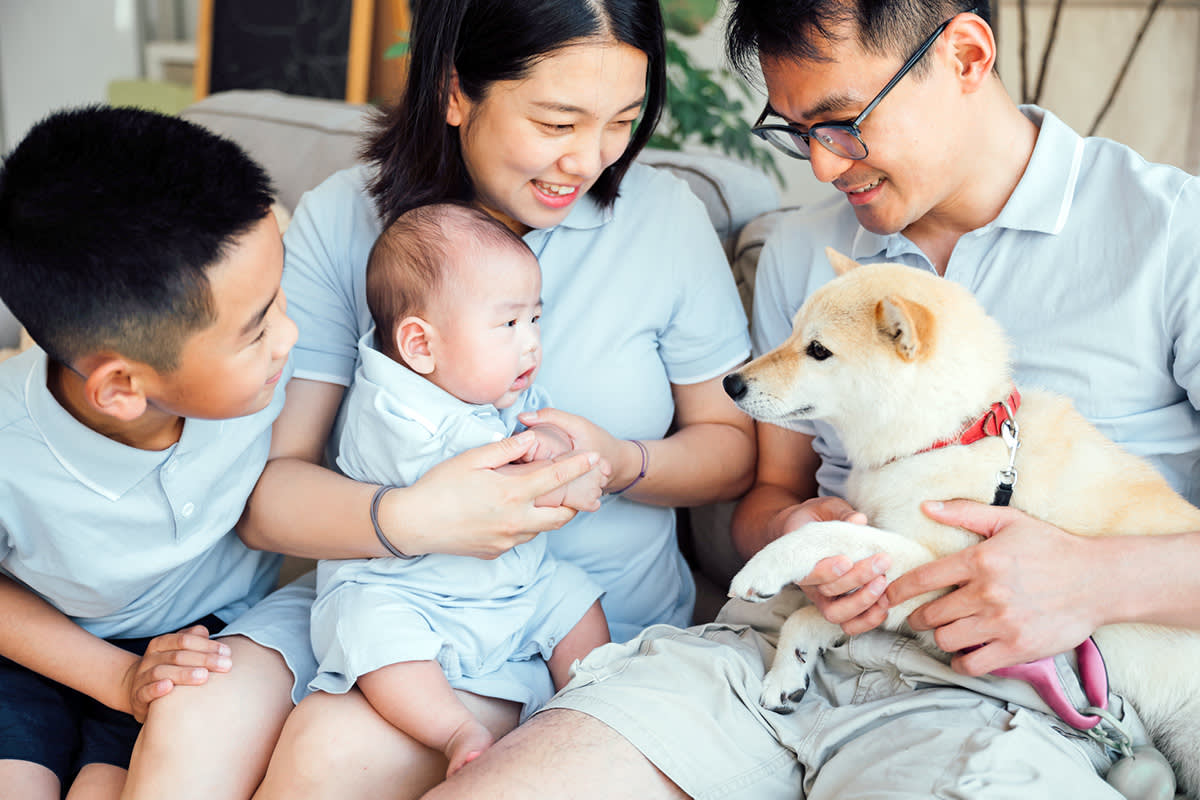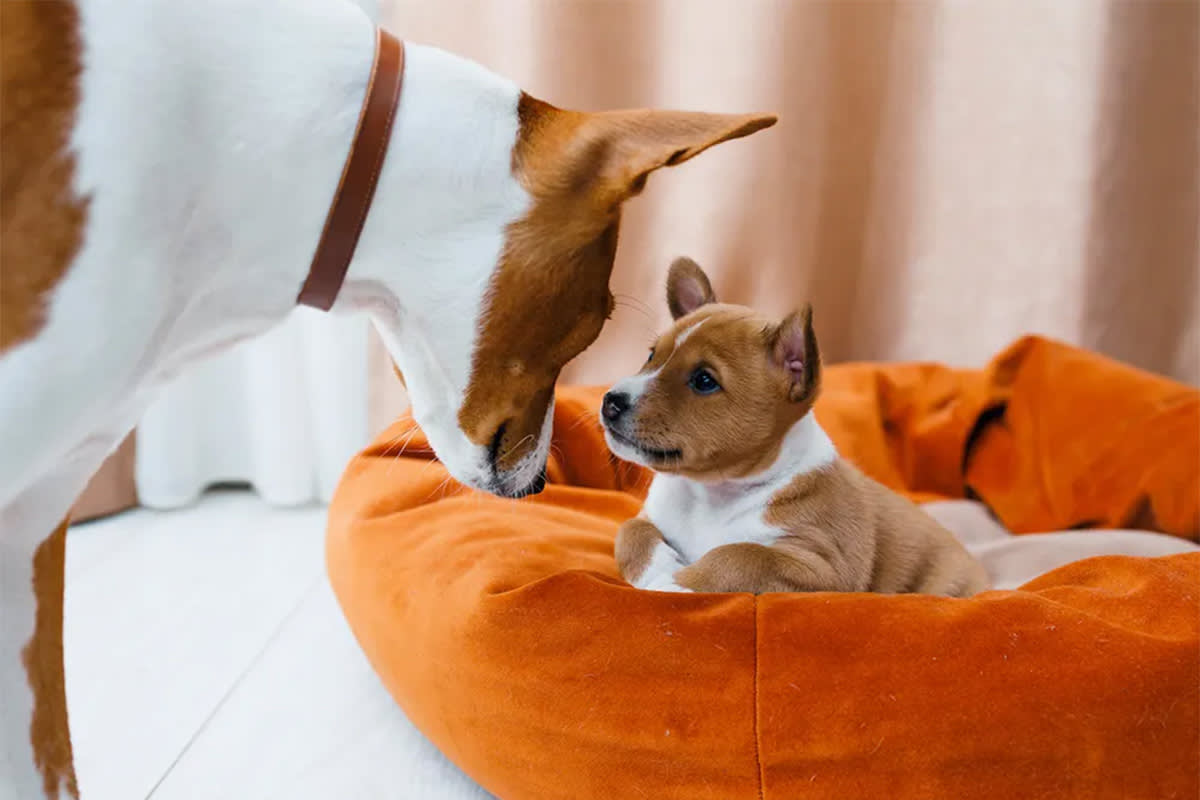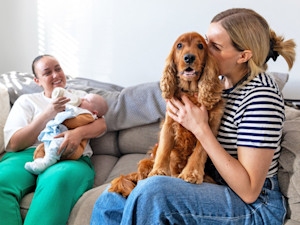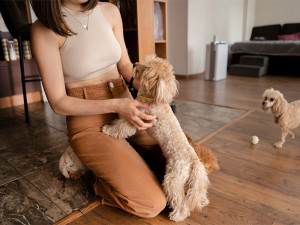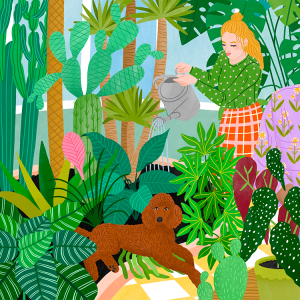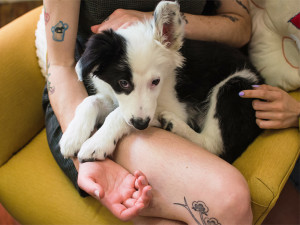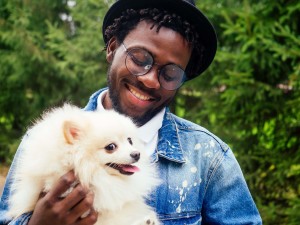You Consider Your Dog a Part of the Family—But Do They See You the Same Way?
Experts say pups definitely know who’s in their “group.”
We’d all like to think that our dogs see us as family (preferably, their parents, but we’ll also take, like, wise older sibling if that’s the dynamic.) That’s why we buy them little beds, feed them special treats, and, in some cases, dress them up in cute outfits so that they, too, can feel the teenage-esque joy of rolling their eyes at an outfit they did not get to choose.
But what really is family to a dog? Do they actually see their pet parents as parent-parents, or are we… something else?
Trick question: All dogs are perfect! But find out which type is the best fit for you.
If you have a precious pup snuggled up against you right now, rest assured, you’re probably their best (human) bud. At the same time, evidence suggests that dogs don’t think of “family” the way we humans do. To truly understand your dog’s feelings about you, you’ve got to consider their side of the relationship, too. So, we asked three experts to explain how dogs picture family, how they understand their bonds with us, and how to make sure we’re giving them the kind of friendship that they want.
Do dogs understand the concept of family?
Well, kind of. Dogs probably don’t think about family in the same way we do, but they do have a strong sense of who their “people” are.
How much do you spend on your pet per year?
Veterinarian Dr. Kate Anderson, assistant clinical professor with the Duffield Institute for Animal Behavior opens in new tab at Cornell University, doubts that dogs understand the term family as an abstract concept. Still, she says, “they certainly form strong emotional bonds with other dogs, humans, and even other species.” Maybe that’s why we’ve all seen those videos of dogs taking care of vulnerable creatures like kittensopens in new tab and ducklingsopens in new tab?
But dogs don’t exactly ascribe to the human family paradigm. In fact, of the roughly one billion dogs living on this planet, an estimated three quartersopens in new tab (750,000,000) live without any specific human family at all.
To behavioral scientist Clive Wynne, Ph.D., founding director of the Canine Science Collaboratory at Arizona State University and author ofopens in new tab Dog Is Love: Why and How Your Dog Loves You, street dogs’ lifestyles illustrate one key facet of the canine psyche: They don’t bother with nuclear families. Instead, he says, they enjoy “much more flexible arrangements.”
Just how flexible are we talking? Wynne does not mince words. “Doggie dads are the worst deadbeat dads you ever came across [in the animal kingdom],” he says. “There’s very little evidence that fathers make any contribution to taking care of the pregnant mothers or the puppies.” I’ll just say it: Woof.
Do dogs understand genetic relationships?
Dogs might not know how to draw a family tree, but that doesn’t mean they can’t identify their relatives. Research suggestsopens in new tab that they can recognize their own kinopens in new tab, and that they can tell when two humans are genetically related or live in the same householdopens in new tab. Erin Hecht, Ph.D., assistant professor at Harvard University’s Department of Human Evolutionary Biology, says that dogs can tell all of this through scent alone.
Interestingly, it seems like dogs might remember some of their relatives better than others. One study publishedopens in new tab in 1994 found limited evidence that mothers and their puppies separated eight to 12 weeks after birth could still recognize one another even after the offspring had reached two years old. Siblings, meanwhile, could not recognize one another, unless they’d lived together.
As fascinating as these revelations might be, Anderson still urges against anthropomorphizing our pets too much: “I don’t believe they necessarily think about who is related or spend time thinking about where their siblings or offspring are or what they are up to.”
Do dogs think of themselves as part of the family?
That might depend on who you ask.
Wynne doesn’t hesitate before saying “absolutely.” Dogs “have an amazing, intense knowledge of who’s in their gang,” he says. “Who’s in their group? Who are they with?” (To see your dog’s affinity for you at work, check out how they greet you versus a random stranger.)
Hecht points out that try as we might, “we can’t really know how dogs see the world.” That said, she believes that dogs likely feel a sense of “group membership” with their human roomies — “whether that’s a biological family, a group of friends sharing an apartment, or something else.”
At the end of the day, Wynne says, the thing dogs and humans have in common is that we’re highly social creatures. Individually, both species are pretty weak when compared to, say, lions, tigers, and bears. “But our strength comes from getting together in numbers,” Wynne says. Because of that, dogs, like humans, “have a deep, ingrained awareness of their group and the rest of the world. And they react differently towards members of their group, versus the rest of the world.”
How to make your dog feel like family
We all have those moments — the ones where we peer over at our beautiful, angelic pup as they gaze up at us with those big, round eyes and think to ourselves, Am I doing enough to make this heavenly creature feel at home?
If you consistently show up for your dog with a good attitude and an open heart, the answer is probably a big, resounding “yes.” Just like with people, building a good bond with your dog starts with a good attitude.
“Dogs learn what to expect from people through experience,” Hecht says. “If you are affectionate, predictable, and a good communicator with your dog, they will expect that from you in the future.” But if a dog is repeatedly abused, “they will come to expect that in the future instead.”
In bonding with your dog, you want to forge a close relationship while also making sure that they can manage those brief moments when you step away during the day or night. Beyond training, this should include giving them ample exercise and leaving them with enriching things to do while you’re gone.
And speaking of training, Anderson notes that not all methods are created equal. In 2023, the British Columbia Society for the Prevention of Cruelty to Animals opens in new tab collected a series of studiesopens in new tab about dog training and examined, among other things, how various techniques affect the human-dog relationship.
Some of the findings were telling:
One cited study found that dogs trained with reward-based methods showed more consistent evidence of secure attachment to their guardians.
Pet parents who reported more frequent use of positive-reinforcement training (R+) also reported a closer bond to their dogs and more perceived attachment.
Meanwhile, dogs whose parents reported positive punishment, negative punishment, and/or negative reinforcement were less likely to interact with their humans and strangers during play than dogs whose humans reported using positive reinforcement.
We all want to make sure we’re doing right by our dogs, but you don’t need to be perfect to convince your dog to love you. At the end of the day, the most valuable thing we can do is to show up kindly and consistently.
“Just be there,” Wynne says. Often, students will ask him what kind of dog they should bring home. But when he asks them about their day-to-day schedules, he finds that they don’t really have time to be home to the degree that a dog will need. They’re busy starting their careers by day and going out by night, which is perfectly fair but not necessarily what’s best for a living, breathing creature who will inevitably spend the day waiting for them to get home.
“People say, ‘Oh, if you really want to strengthen the bond with your dog, you’ve got to do agility,’” Wynne says, “You’ve got to do nosework. You’ve got to be training the dog.’ You don’t have to do any of those things. You just have to be there. That’s what you need to do. You need to be there.”


